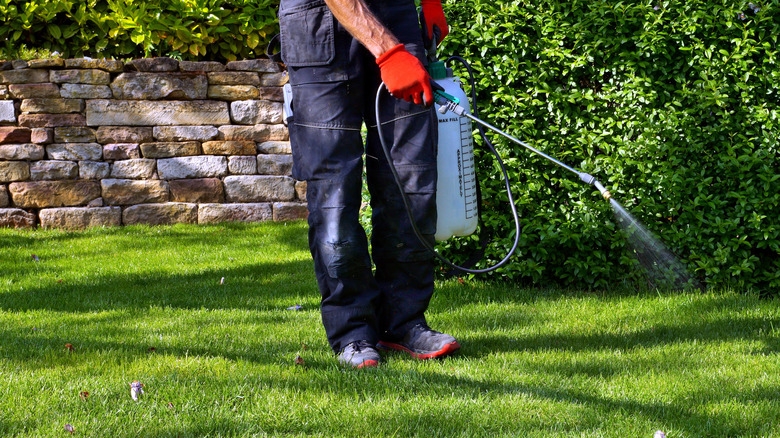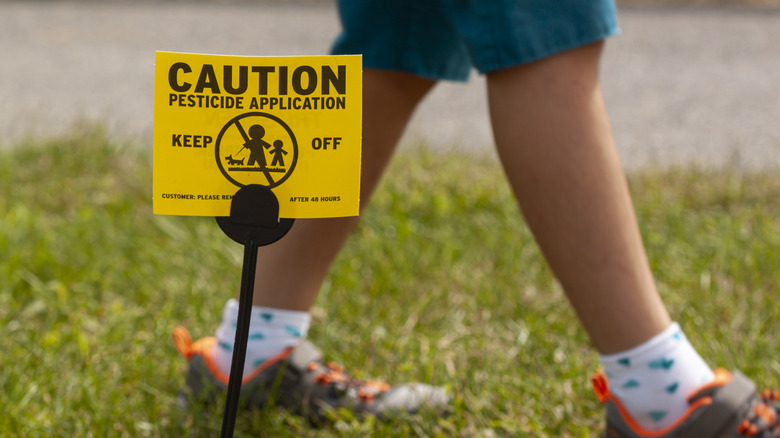The Most Important Place To Use Pesticides That You're Probably Missing
Pesticides are not a modern invention. In fact, ancient Sumerians' crops were protected by sulfur, and arsenic was used in gardens during the Middle Ages, according to FoodPrint. Now, more than 1 billion pounds of pesticides are used each year in the U.S., the U.S. Geological Survey reports: Insecticides, fungicides, and rodenticides are applied to yards and gardens, as well as to combat unwanted home invaders. You may be on high alert for those pests that invite themselves into your house, but it is equally important to prevent them from coming inside in the first place. Applying pesticides to the perimeter of your house is an effective way to keep the interlopers out before you need to reach for the bait, traps, or sprays inside.
DoMyOwn recommends applying a liquid insecticide every 90 days or monthly if there is a heavy infestation. Granules can also be used, and insecticide dust is another weapon. If you want to get rid of the protection, power washing will do the job, and so will laying mulch over it.
Spread them around all access points
Spraying pesticides around access points like windows, vents, and door frames is best as they are especially effective against crawlers such as millipedes, centipedes, and earwigs. Extend the safety moat by applying deterrents to hideouts, including garage or shed doors and windows. A more natural approach is to create a barrier of aromatic herbs, essential oils, cinnamon, neem oil, or vinegar around your house (via SLC.gov). I Love Turf cautions that some wily insects can figure out ways to skirt around the poisons and slip into your home, so don't overlook access points where utilities enter the house.
You can establish a pest-free zone by applying the solution several feet up the side of the property and extending the protective barrier several yards outward. Copesan warns against spraying to the extent it might also taint herbs or vegetables. Cover a nearby fishpond or cooking area before widespread use, and don't water the yard or garden immediately after setting up the perimeter. You should also avoid using pesticides in the rain so you don't contaminate other areas.
If granules are used, be mindful that friendly animals might contact them, per Solutions Pest & Lawn. A study published in the International Journal of Environmental Research and Public Health warns against the domino effect of pesticides. For example, a bird could be sickened by eating an insecticide-ridden spider, so choose the solutions carefully and ensure they are specifically targeted. Avoid using them on pollinators or near hives.
Safe pesticide practices
The University of California advises using pesticides only as a last resort or as part of an integrated program that may also include weeding, hoeing, pruning, and encouraging beneficial insects. One should try to head off the problem before it starts by encouraging a healthy outdoor environment. Good indoor habits and behavior should also be practiced to minimize indoor attractants. Many plant problems are non-pest in origin (abiotic), and pesticides may not even be the solution in those cases.
According to Pesticide Environmental Stewardship, you shouldn't set up a perimeter when the wind exceeds 8 mph. Spray with the wind at your back. Temperatures higher than 90 degrees may cause pesticide ingredients to vaporize and drift, so use coarse droplet settings on sprayers to lessen widespread dispersal. The label is the ultimate arbiter of proper pesticide usage. Always consult it before applying one, EPA notes; instructions should be followed to a T. Make sure you are targeting only what the product is recommended for.
The University of Nebraska Lincoln also does not support the use of broad-spectrum pesticides, which might be detrimental to friendly insects. Do spot treatments only if you must use them. The National Pesticide Information Center advises using pesticides with the lowest level of toxicity and instructs the user to be ready to respond to a spill. Use paper towels, cat litter, or sawdust to clean it up. Do not use water, which may only spread the contaminant.


